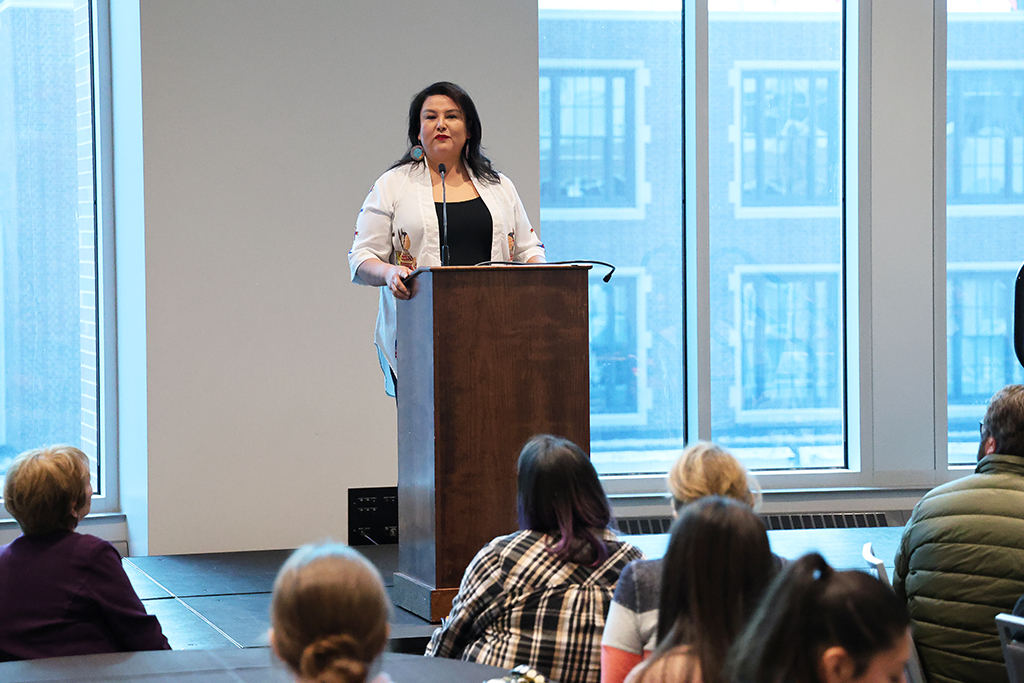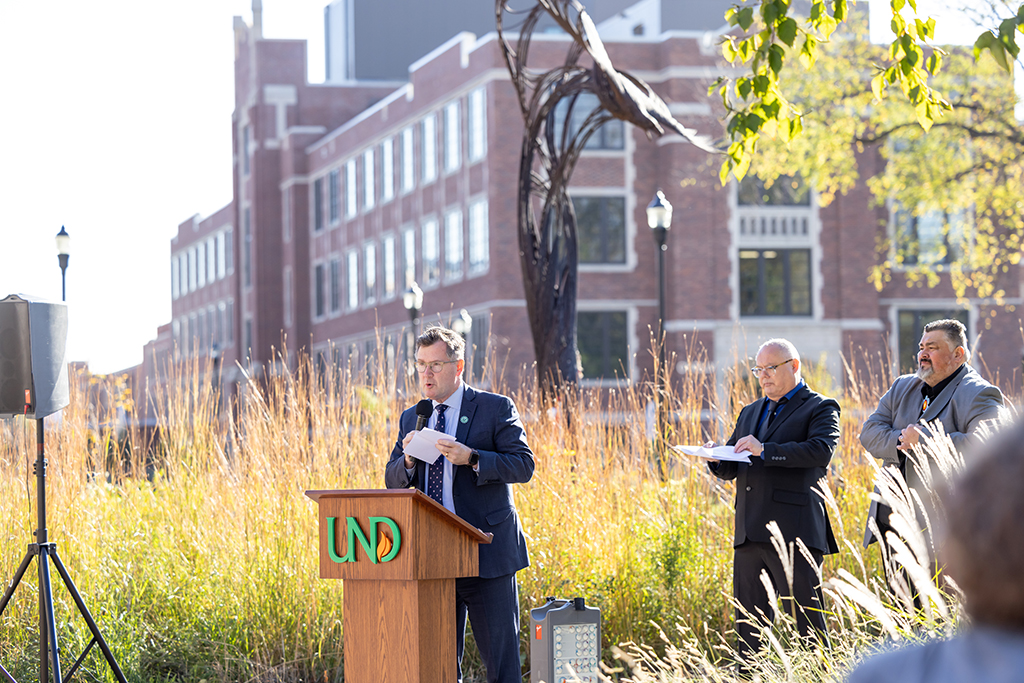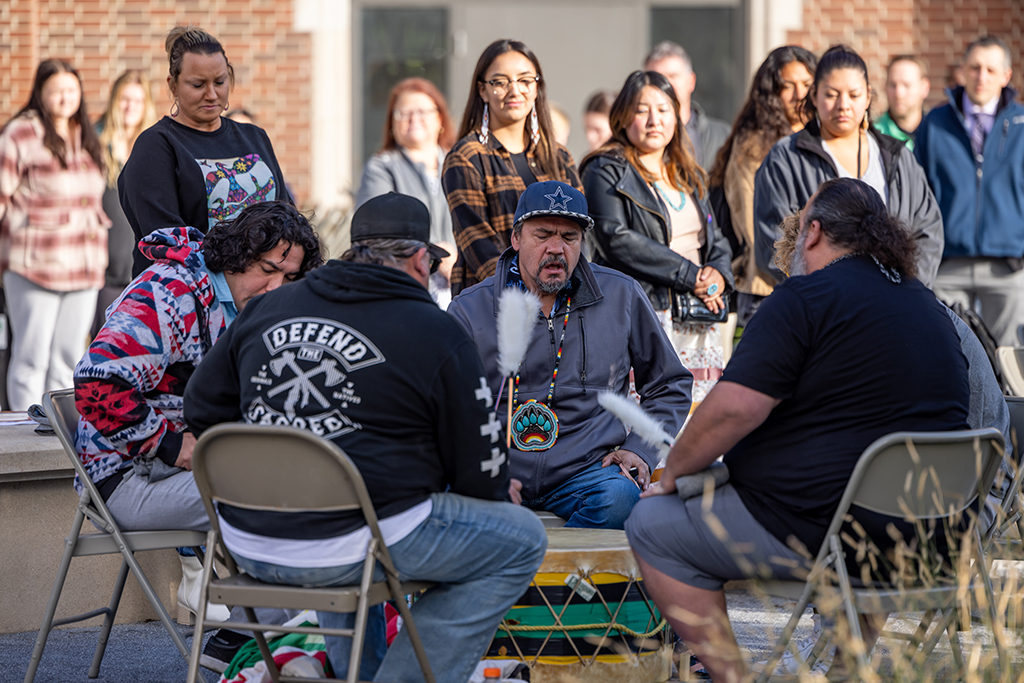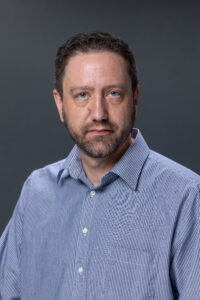UND celebrates ‘a great day to be Indigenous’
Keynote speaker, dedication of the renewed Soaring Eagle Garden mark Indigenous Peoples’ Day celebration

Jayme Davis, a member of the Turtle Mountain Band of Chippewa and Standing Rock Sioux tribes, told attendees of the UND Indigenous Peoples’ Day celebration that despite past tragedies, Indigenous cultures are a living part of American history — a part that is not only unique to North America, but also requires understanding and dialogue to flourish.
Judging by the successful turnout at the pair of events that made up the UND’s Indigenous Peoples’ Day celebration, she may have furthered that cause.
The dual UND events were held on Monday, Oct. 9. Davis, who also serves as a state representative from Rolette, N.D., gave the keynote address in the Memorial Union Ballroom on Monday afternoon, following a morning ceremony to dedicate the newly renovated Soaring Eagle Prairie Garden. Both events drew crowds of UND administrators, faculty, staff members and students.
“Indigenous cultures are a testament to human adaptability and remarkable human ingenuity,” Davis said. “We have survived and thrived in diverse environments, from the Arctic tundra — although we sometimes call here the Arctic tundra — to arid deserts, and to the rich seasons we have here, right in the heart of Turtle Island.”
The latter term refers to the Earth, or North America, and is derived from a creation story shared by many Indigenous cultures across the nation.
Davis said Indigenous people have a responsibility to make sure their cultural heritage endures for future generations. That can be achieved through several ways, but recognizing the importance of Indigenous Peoples’ Day is one way, and outreach, even in the form of a conversation with a stranger, is another.
Not everyone, she said, understands the impact the arrival of European settlers – and the violence, dispossession of lands, and suppression of Indigenous cultures that followed – has had on Indigenous people. But a dialogue can change that.
“One of the most powerful aspects of Indigenous Peoples’ Day is the potential to foster dialogue and understanding among all of our citizens,” she said. “This encourages us to engage in meaningful conversations about the history, culture, and the contemporary issues facing our Indigenous communities and nations. It is time we work together toward a more just, inclusive future.”

And with that, Davis turned her address into a dialogue, and engaged with the crowd.
William Sheridan, biology professor, wondered if she agreed with the idea that difficulties experienced on reservations across the country would only be remedied by their economic independence. He said the idea is found in the book “Notes from the Center of Turtle Island,” by Duane Champagne.
Davis responded that it is important, and remains a challenge, to ensure the United States upholds its treaties with Indigenous peoples. Still, she said, it’s necessary to foster the attitude that “nobody is going to come and save us,” and that Indigenous citizens must “step up” engagement in their own communities.
Erika Red Tomahawk, from Standing Rock, agreed with Davis on the need to keep open a dialogue between people. She called on attendees to not be afraid to interact with Indigenous UND students and said that doing so can make people feel more welcome in the broader UND community. She recalled her own experiences adapting to life on campus, and her desire to leave when she first came to UND in 2021, but also the optimism she now feels after deciding to stay the course.
“Don’t be afraid to say ‘Hi,’” Red Tomahawk said. “If anything, you’re helping them more than you know.”
The Sloughfoot drum group, which opened the address with an honor song, then provided the beat for a round dance, with everyone in the crowded section of the Memorial Union Ballroom joining hands to dance a circle around the room.
Dedicating the Soaring Eagle Prairie Garden

Preceding the keynote address was the dedication of the Soaring Eagle Garden. As with the address, Keith Malaterre, director of the Indigenous Student Center, began the morning event by reading the UND Land Acknowledgement statement, which seeks to “show respect, recognition, and gratitude to Indigenous Peoples who call the land home.”
Following Malaterre’s introduction, Dan Henry, director of the Indians into Medicine program, said the Indigenous peoples are frequently referred to as “resilient,” but said that “strength” is a more likely descriptor. It is strength that has seen these groups of people survive through centuries on the continent.
Malaterre made sure to mention that the weather, which had changed from brisk and overcast to sunny and warm, was an auspicious sign of the day to come.
“When we were setting up, it was overcast, and it almost looked like there was going to be rain,” he said. “Then when we started, the sun came out. So that’s a sign that this is a good day, and it’s good to be Indigenous.”
The Soaring Eagle sculpture was first dedicated in early Oct. 2000, and was created by the renowned Indigenous artist Bennet Brien, who received an MFA from UND. The sculpture was a gift from Grand Forks native and UND alum Col. Eugene E. Myers, who was a high ranking officer in the U.S. military, and held leadership roles at several major galleries and universities.
The surrounding garden came two years later, and was, Malaterre said, the brainchild of Glinda Crawford, a Sociology professor at UND from 1975 to 2005. Crawford passed away in 2016, but fittingly, her daughter Melanie made the journey from Wisconsin for the dedication ceremony, where she was asked to stand and be recognized.
Malaterre fondly recalled a memory with Glinda Crawford:
“I remember walking by here and Glinda would be weeding the garden by herself,” he said. “She was just an amazing, amazing woman.”
Today, the garden contains medicinal plants such as cedar, sage and sweetgrass, among others. The garden is ringed by a wide stone bench and provides a place for people to sit and reflect.
UND President Andy Armacost also spoke at the dedication event, and thanked people for attending. He said the garden was previously not very glamorous but has become transformed with its renovation, along with the new pedestrian walkway that extends from behind the Memorial Union and through the heart of the campus. He thanked all of those involved in renewing the garden, and said it is a location in which anyone can sit and find solace but is also a place that should inspire understanding.
“I’m proud that this represents a physical space for the recognition of what happens on our campus with respect to supporting our Indigenous members,” Armacost said.




